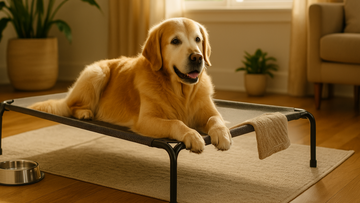If you're caring for an aging dog, you know comfort is essential. Orthopedic dog beds for senior dogs significantly improve quality of life, especially elevated or raised dog beds. Raised dog beds reduce joint pain, enhance hygiene, and offer unmatched support—making them ideal for your elderly furry companion.
Why Orthopedic Raised Dog Beds Are Essential for Senior Dogs
When our furry friends age, they need extra care and support—just like humans. Orthopedic raised dog beds are not merely stylish furniture for your home; they offer practical health benefits that significantly boost your senior dog's quality of life. With elevated designs, these beds provide superior support and comfort, significantly reducing discomfort and enhancing sleep quality. They keep your dog off the cold, hard floor, preventing stiffness and aches that come from lying on rigid surfaces. Additionally, the raised structure promotes airflow, making the environment healthier and more comfortable for your elderly pet. Investing in an orthopedic raised bed isn’t just about luxury—it’s about giving your aging dog the best possible quality of life.
Alleviating Joint and Arthritis Pain
Senior dogs often struggle with joint pain, arthritis, or other mobility issues, making comfort a top priority. Raised orthopedic dog beds offer crucial support by evenly distributing your dog's weight across the sleeping surface. Unlike traditional soft beds that collapse under the weight of your dog, orthopedic raised beds retain their shape, maintaining firm yet gentle support. This reduces painful pressure points around hips, elbows, and shoulders—areas commonly affected by arthritis. Orthopedic raised beds are particularly beneficial for larger breeds, whose extra weight makes joint problems even more pronounced. These beds significantly improve your dog’s mobility, allowing your elderly companion to rise easier, move more freely, and maintain a healthier, happier lifestyle.
Superior Cooling and Ventilation
Older dogs often have trouble regulating their body temperature, making temperature control crucial for their comfort and health. Raised dog beds are designed specifically with superior airflow in mind. With a breathable mesh surface and a gap between the bed and the ground, these beds allow air to circulate beneath your dog. During hot summer months, this cooling effect significantly reduces overheating, making your senior dog more comfortable and less prone to heat exhaustion. Conversely, during colder months, you can add blankets or pads to keep the bed cozy, making it a versatile year-round solution. This adaptability helps ensure your elderly pet remains comfortable no matter the season or temperature, promoting restful sleep and better overall health.
Improved Health and Hygiene
As dogs age, maintaining hygiene becomes increasingly important. Traditional dog beds can quickly accumulate hair, dirt, moisture, and bacteria, creating an unhygienic sleeping environment. Elevated orthopedic beds, on the other hand, offer a cleaner and healthier alternative. The raised design allows dirt, hair, and allergens to fall away from the sleeping area, reducing exposure to irritants that can trigger allergies or respiratory issues. Additionally, senior dogs who might struggle with incontinence or occasional accidents benefit from the quick-draining mesh fabric that keeps the sleeping surface dry and comfortable. These beds are generally easier to clean—often requiring only a quick hose-down—making regular sanitation straightforward. Ensuring your dog's sleeping area remains hygienic not only enhances their comfort but also significantly reduces health risks associated with poor sanitation.
Chew-Resistant Design
Senior dogs, particularly those experiencing anxiety, stress, or cognitive decline, may exhibit destructive chewing behavior. Traditional soft beds often become targets for this behavior, quickly becoming shredded and unusable. Orthopedic raised beds feature robust designs with sturdy metal or durable plastic frames and chew-resistant fabric that can withstand significant chewing attempts. This durability is particularly beneficial if your senior dog tends to chew out of boredom, discomfort, or anxiety, helping you avoid repeatedly replacing beds and saving you money in the long run. Investing in a chew-resistant orthopedic raised bed thus ensures longevity and provides a safe, durable sleeping area that reduces the likelihood of accidental ingestion of bed materials, a potential health hazard for dogs prone to destructive chewing.
Choosing the Right Orthopedic Raised Dog Bed for Your Senior Dog
Selecting the Right Size
Selecting the appropriate size for your dog's bed is critical. A bed too small will cause discomfort, while excessively large beds might make your dog feel insecure or unsupported. To choose the perfect size, measure your dog from the tip of the nose to the base of the tail, and add a few inches for comfortable stretching. If your dog enjoys sprawling out, opt for a larger bed, while curlers might prefer a slightly more compact space. Proper sizing ensures your senior dog receives maximum orthopedic benefits, fully utilizing the supportive surface of the raised bed, resulting in optimal joint relief and improved sleep quality.
Considering Comfort and Stability
Comfort goes hand-in-hand with stability. Senior dogs often struggle with balance and coordination issues. A stable, well-constructed raised bed provides reliable support, making it easier for your pet to climb onto and off the bed safely. Look for beds with non-slip feet to ensure stability on various surfaces. Comfort isn’t only about cushioning—it's also about how secure your dog feels on their bed. Choosing a bed that combines orthopedic cushioning with structural integrity will greatly enhance your dog’s comfort, encouraging regular use and promoting better rest.
Benefits Compared to Traditional Dog Beds
Orthopedic raised dog beds offer distinct advantages over traditional beds, especially for older dogs. Conventional foam or plush dog beds may initially seem comfortable but often lack sustained support. Over time, traditional beds become flattened and lose their supportive qualities, exacerbating existing joint issues in senior dogs. Orthopedic elevated beds solve these problems by offering a consistent level of firm yet gentle support that never flattens or wears down, maintaining proper joint alignment and comfort. Additionally, raised beds significantly outperform traditional beds regarding hygiene and durability. They stay cleaner, reducing risks of infection and allergens—a major concern for aging dogs whose immune systems may be compromised.
Another critical benefit is temperature regulation. Traditional dog beds trap heat, making your elderly dog uncomfortable, particularly during warmer months. In contrast, elevated designs improve ventilation, allowing heat and moisture to dissipate. This helps prevent common skin conditions and hotspots, promoting healthier skin and coat conditions. Ultimately, choosing a raised orthopedic bed for your senior dog not only enhances their comfort and health but can also be a more cost-effective option long-term, considering the durability and lower maintenance costs.
Features to Look for in Orthopedic Raised Beds
Material Durability and Quality
When shopping for a raised orthopedic dog bed, the quality and durability of the materials are crucial. The bed frame should ideally be constructed from strong materials such as steel or aluminum, capable of supporting your dog’s weight without sagging or buckling. Beds made from high-quality fabrics like ballistic nylon or heavy-duty polyester offer superior durability, resisting wear and tear from daily use. Look specifically for chew-resistant materials if your dog tends to chew, as these will significantly increase the lifespan of the bed.
Additionally, inspect the stitching quality. Well-sewn seams prevent fraying and tearing, contributing to the bed’s longevity. Remember, a quality orthopedic bed represents an investment in your pet's well-being and your long-term peace of mind. Spending a bit more on superior materials often results in greater savings over time, as you'll avoid frequent replacements.
Breathability and Hygiene Factors
The fabric and overall design should allow excellent airflow, reducing moisture accumulation and keeping your senior dog comfortable. Mesh fabrics are ideal for their breathability, ensuring adequate ventilation and minimizing overheating issues. Additionally, breathable materials help manage odors and bacteria buildup, ensuring a hygienic sleeping environment. Hygiene features like moisture-resistant or quick-draining materials are essential, particularly for elderly dogs prone to accidents.
The best beds also include antimicrobial treatments or materials that naturally resist bacterial growth, providing additional protection against infection. Such hygienic features reduce the amount of time spent cleaning and contribute significantly to your pet’s overall health.
Ease of Cleaning and Maintenance
Ease of maintenance is a key consideration. Raised orthopedic beds are typically easy to clean, usually requiring a simple wipe-down or rinse. Look for beds with removable, washable covers for extra convenience. Beds that can be hosed down and dry quickly are ideal, especially for busy dog owners. This simplicity in maintenance ensures your dog’s sleeping area remains consistently clean and comfortable, reducing your workload while promoting optimal health for your aging pet.
Tips to Introduce Your Senior Dog to a Raised Bed
Introducing your senior dog to a new raised orthopedic bed requires patience and gradual transition. Start by placing familiar items, like your dog's favorite toys or blankets, on the new bed to make it more inviting. If your dog initially resists, encourage them gently with treats and positive reinforcement, associating the bed with pleasant experiences. Place the new bed near their previous sleeping spot, gradually moving it to its final location over several days.
Older dogs may take longer to adjust to changes, so patience and consistency are essential. Never force your dog onto the bed, as this could create negative associations. Gradually building a positive routine around the raised bed ensures a smooth transition, allowing your senior dog to benefit from the orthopedic support without stress or anxiety.
Common Mistakes to Avoid When Buying Orthopedic Beds
One common mistake dog owners make is prioritizing aesthetics over functionality. While an attractive bed might complement your décor, it won’t necessarily meet your senior dog's orthopedic needs. Always prioritize support, comfort, and functionality over appearance. Another mistake is purchasing beds based solely on cost. Cheaper beds might seem attractive initially, but they usually lack durability and proper orthopedic support, leading to frequent replacements and additional expenses.
It's also important to avoid selecting the wrong size. Beds that are too small restrict your dog's movement, causing discomfort, while excessively large beds may fail to offer proper support. Carefully measure your dog and consider their sleeping habits before making a purchase. By avoiding these common mistakes, you'll ensure your senior dog gets the right orthopedic raised bed tailored precisely to their needs.
Cost vs. Comfort: Is an Orthopedic Raised Bed Worth the Investment?
Deciding if an orthopedic raised dog bed is worth the investment often comes down to balancing upfront cost against long-term comfort and health benefits for your dog. Initially, orthopedic raised beds can seem pricey compared to basic, traditional beds. However, when you factor in the significant advantages they provide, especially for senior dogs, the value becomes clear.
Investing in an orthopedic raised bed translates into fewer vet visits, reduced medication for arthritis, and better overall health for your pet, ultimately saving you money in the long run. These beds offer exceptional durability and last significantly longer than standard beds, particularly because they are designed to withstand heavy usage and chewing behaviors common in older dogs.
Moreover, the comfort these beds provide your aging companion cannot be overstated. Your senior dog deserves restful, pain-free sleep, which directly impacts their mood, behavior, and general well-being. Improved comfort leads to increased energy levels, reduced stress, and enhanced quality of life, making orthopedic raised beds worth every penny.
Customer Testimonials: Real-Life Experiences
Hearing from real dog owners can reinforce the decision to purchase an orthopedic raised bed. Many pet parents report substantial improvements in their dogs' mobility, energy, and overall mood after switching to elevated orthopedic beds. For instance, owners frequently share stories of dogs who previously struggled to get up from soft, plush beds, now moving with ease and excitement.
One common testimonial involves senior dogs previously waking stiff and uncomfortable, dramatically improving after just a few nights on an orthopedic raised bed. Pet parents also highlight how easy these beds are to clean, significantly reducing hassle and maintaining hygiene effortlessly.
Such testimonials underscore the tangible benefits these beds offer, providing reassurance and real-world evidence of their effectiveness in promoting health, happiness, and comfort for senior dogs.
Alternatives to Orthopedic Raised Dog Beds
While raised orthopedic beds are excellent, they aren't the only option. Memory foam dog beds, for example, offer substantial support by molding to your dog's body, though they don't provide the same ventilation benefits. Heated beds or cooling mats can be good choices if your dog's main issue is temperature regulation.
However, each alternative comes with limitations—memory foam can retain heat, making it uncomfortable during warm weather, and heated beds can be challenging to clean and maintain. Therefore, while alternatives exist, raised orthopedic beds typically offer the best blend of support, hygiene, durability, and temperature regulation, making them uniquely suited to senior dogs' comprehensive needs.
Maintenance Tips for Long-term Use
To maximize the lifespan of your orthopedic raised dog bed, regular maintenance is key. Periodically inspect the frame for signs of wear, tightening screws or bolts as needed. Regularly clean the fabric surface by wiping it down or rinsing it to remove dirt, hair, and debris, reducing bacterial growth and odors.
Additionally, consider placing a protective cover or pad on the bed to further protect against damage or wear. If your dog is prone to accidents, promptly address any messes to avoid lingering odors or stains. Regular, proactive maintenance not only extends the life of your investment but also ensures your dog consistently benefits from a clean, supportive sleeping environment.
Enhance Your Dog's Comfort Today
Your aging companion deserves comfort, support, and quality sleep. Orthopedic raised dog beds are more than just furniture—they're essential to your senior dog's health and happiness. Explore our curated selection of orthopedic raised dog beds specifically designed for senior dogs and ensure your beloved pet enjoys the quality of life they deserve. Make the switch today and see firsthand the positive impact a proper orthopedic bed can have on your dog’s comfort and well-being.
Conclusion
Orthopedic raised dog beds provide unmatched comfort and numerous health benefits, especially for senior dogs facing joint pain and mobility issues. Offering superior joint support, improved hygiene, easy maintenance, and increased durability, they stand out clearly against traditional beds. Investing in an orthopedic raised dog bed is a proactive step toward ensuring your elderly dog's health, comfort, and overall happiness for years to come.
Frequently Asked Questions (FAQs)
Q1: Do orthopedic dog beds really help senior dogs?
Absolutely! Orthopedic dog beds significantly help by alleviating joint pain, improving sleep quality, and providing consistent support that older dogs desperately need.
Q2: Why should I choose an elevated orthopedic dog bed over a regular bed?
Elevated orthopedic dog beds offer better airflow, hygiene, durable support, and temperature regulation—ideal for older dogs suffering from arthritis or mobility issues.
Q3: Are elevated orthopedic beds easy to clean?
Yes! Most elevated orthopedic beds feature washable, easy-to-maintain surfaces that can be quickly cleaned, making them ideal for older pets.
Q4: How can raised orthopedic beds reduce arthritis pain?
By evenly distributing weight and providing consistent firm support, raised orthopedic beds relieve pressure from painful joints, significantly reducing arthritis-related discomfort.
Q5: Will my senior dog adapt easily to an orthopedic raised bed?
Most senior dogs quickly adapt, appreciating the comfort and stability these beds offer. Gradual introduction and positive reinforcement make the transition seamless and stress-free.



